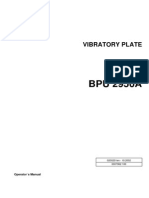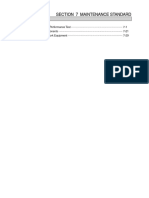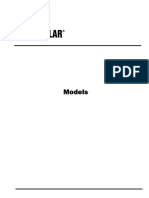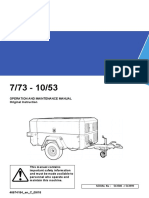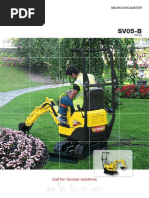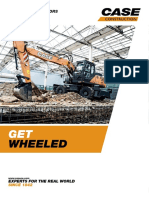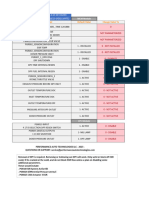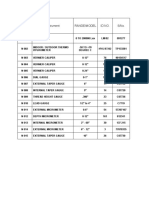THWAITES Dumpers IM1619066118 - 1
THWAITES Dumpers IM1619066118 - 1
Uploaded by
marcelo diazCopyright:
Available Formats
THWAITES Dumpers IM1619066118 - 1
THWAITES Dumpers IM1619066118 - 1
Uploaded by
marcelo diazOriginal Title
Copyright
Available Formats
Share this document
Did you find this document useful?
Is this content inappropriate?
Copyright:
Available Formats
THWAITES Dumpers IM1619066118 - 1
THWAITES Dumpers IM1619066118 - 1
Uploaded by
marcelo diazCopyright:
Available Formats
5 - 10 Tonne
MACH497, 498, 492, 490,
494, 550, 555, 557, 560, 564,
Operator’s
565, 566, 568, 569
Instruction
Manual
©Thwaites Limited 2007
Tier II: issue 5
T0474
Mach 564 – 6 Tonne Powerswivel Mach 565 – 6 Tonne Front Tip
Introduction
Thwaites Limited puts Safety First wheeled loads.
It is the policy of Thwaites Limited to promote safety in the Due to the varied nature of the operation of site dumpers and
operation of its machines and to create a general awareness of the absence of an agreed test standard, any figures quoted
site safety and safe working practices for the operators of its by Thwaites in relation to vibration values and exposure are
machines. for reference purposes only. It is the responsibility of the
This Operator’s Instruction Manual is intended for both new employer to assess vibration exposure based on the actual site
and experienced machine operators. It should remain with conditions, and operating practices, at the point of use.
the machine at all times. All operators should be aware of its Hand Arm Vibration - The daily exposure Action/Limit Values
location and contents. of between 2.5 - 5.0m/s2 (A8) are unlikely to be exceeded in an
It is important that all operators are fully trained and familiar eight-hour reference period.
with the machine and that they have read and understood the Whole Body Vibration - The daily exposure can only be
information contained within this book before they attempt accurately determined at the point of use. This exposure must
to operate in the site conditions for which the machine was be managed in respect of the Action/Limit Values of 0.5 and
designed. 1.15 m/s2 (A8) respectively.
This book details practices and operations which Thwaites Employers should not rely solely on published vibration
Limited recommends. DO NOT operate this machine in ways figures when undertaking risk assessments. Depending on the
other than those detailed within this book. site conditions, cycle times may need to be adjusted in order
This machine is designed for customary construction site to reduce operator exposure levels.
operations, and the transportation of bulk materials commonly Vibration values based on typical duty cycles are available
carried on such sites; that is their ‘intended use’. Under certain on request from Thwaites. These may be used for reference
controlled conditions the dumper may be used for towing purposes only.
Safety symbols
• Attention! • Correct action • Incorrect action/procedure
• Be alert! which should NOT be carried
• Your safety is involved! out
Signal words
Signal words are used on the machine and within this manual to identify levels of hazard seriousness:
danger warning caution
1 Before operating this machine
Read operator’s instruction manual
Distributor
1. Contact your Thwaites representative in case of
further questions
2. Learn to operate this machine
3. Ensure you are fit to operate
4. Wear correct safety clothing and ensure that safety
equipment is available
Complete checks in section before starting the engine
1 Before operating this machine
Visually check the machine
1 Are the chassis lock and the skip lock disengaged?
2 Are the controls, crush zone or hydraulic rams
Walk around the machine 3
clean, and clear of any debris?
Is the Roll-Over Protective frame (ROPS frame)
secure, fully upright and undamaged?
4 Is the seatbelt anchorage secure and serviceable?
5 Are the covers and mudguards secure?
6 Are the hoses free from fluid leaks?
7 Are all safety decals legible?
8 Are the tyres free of cuts or splits?
9 Are all bolts tight and in position?
10 Have the daily maintenance tasks been
performed? (See rear cover)
Report all faults immediately.
WARNING
Incorrect tyre pressures reduce machine stability.
DO NOT OPERATE THE MACHINE UNTIL
ALL FAULTS HAVE BEEN RECTIFIED
Complete checks in section before starting the engine
1 Before operating this machine
Mount the machine and check the controls
1 Use the grabrails and foot steps provided to
manoeuvre into seating position. Face the machine
at all times when mounting and dismounting
2 Is the engine cover secure and locked?
3 Adjust the seat position for comfort and easy
access to controls
4 Fasten the seatbelt. Adjust accordingly for safety
and comfort
5 Is the hand brake ON?
6 Set the transmission to neutral
7 Does the foot brake feel firm?
8 Do not operate the machine without understanding
all its controls as described in the following pages
WARNING
A seatbelt MUST BE WORN when operating machines
fitted with a ROPS frame
Complete checks in section before starting the engine
1 Layout of controls
Control locations and functions
1 Steering wheel
2 Direction indicator selector -
Forward = left turn - back = right turn*
3 Lights - twist 1 = sidelights ON -
twist 2 = dipped headlights ON*
4 Up = flash. Down = main beam*
5 Hazard warning light switch*
6 Beacon switch
7 Foot brake pedal
8 Throttle pedal
9 Parking brake lever
10 Engine oil pressure warning light
11 Water temperature warning light
12 Transmission oil pressure warning light
13 Headlight main beam pilot light*
14 Direction indicator pilot light*
15 Transmission oil temperature warning light
16 Low brake fluid warning light*
17 Battery charging warning light
18 Horn push
19 Bucket raise/lower/rotate lever
20 Gear lever (powershuttle only)
21 Dump valve pedal
CB1 Fuel/direction solenoids 22 Circuit breakers (push to reset)
CB2 Instrumentation/warning 23 Hand brake warning buzzer
CB3 L/H sidelights*
24 Ignition switch
CB4 R/H sidelights*
CB5 Ignition fed lights 25 Forward/neutral/reverse lever (powershuttle)
CB6 Battery fed lights Gear/forward/reverse lever (powershift)
26 Maxi fuse (under engine cover)
* Optional items
Complete checks in section before starting the engine
1 Control functions - in depth
Seat adjustment
A – Turn knob to set driver weight
B – Lift to slide seat assembly forwards/backwards
C – Lift handle to adjust backrest
Seatbelt
• Adjust length of belt when seated
• Press buckle blade into buckle lock
• Pull belt webbing through buckle blade to remove slack
Seatbelt should not be worn loose. It should pass comfortably across hip
bones and not the abdomen
Throttle pedal - right foot
• Apply pressure to increase speed
• Release pressure to reduce speed
Foot brake - right foot
Apply pressure to slow or stop the machine
Dump valve pedal - left foot
Press down before each gear change - select gear, then release
Complete checks in section before starting the engine
1 Control Functions - in depth
Forward/neutral/reverse lever (FNR lever) (powershuttle) -
left hand
• Push forwards to travel in a forward direction
• Lever centred = neutral
• Pull back to travel in a reverse direction
Gear lever (powershift) - left hand
• Up changes - anti-clockwise selects gears 1 to 4
• Down changes - clockwise selects gears 4 to 1
Warning - Overspeed time delay sensor fitted
Gear lever (powershuttle only) - left hand
forward-left forward-right
first gear third gear
neutral
back-left back-right
second gear fourth gear
Hand brake lever - right hand
• Use only when the machine is stationary (or in an emergency)
• Pull lever up to apply
• Push button and lower lever to release
An audible warning device is fitted to your machine. This will sound if the
parking brake is engaged whilst forward or reverse is selected.
Complete checks in section before starting the engine
1 Control functions - in depth
Steering wheel - both hands
• Turn the wheel clockwise to turn machine to right
• Turn the wheel anti-clockwise to turn machine to left
Ensure the non-steering hand is on the engine cover grabrail when using the
spinner knob for low-speed single handed steering
Tipping control lever (front tip models) - left hand
• Push forward to raise skip
• Push backward to lower skip
Tipping control lever (powerswivel models) - left hand
• Raise skip 100 mm (4”) to disengage pivot centring lock
• Rotate skip to a central position (fully lowered) to automatically
engage centring lock
• Raise skip and push lever to the right to rotate skip clockwise
• Raise skip and push lever to the left to rotate skip anti-clockwise
• Increased engine speed reduces cycle times
Movement of the bucket is disabled if the steering wheel is moved (steering
is given priority)
Opening and closing the engine cover
• Insert ignition key and turn anti-clockwise to unlock
• Pull handle to release and raise cover
• Lower cover, secure and lock before driving
Complete checks in section before starting the engine
1 Control Functions - in depth
Lowering and raising the ROPS frame
• Remove linch pins and withdraw frame lock pins
• Lower frame and insert lock pins and linch pins in new position
• Reverse the procedure to raise the frame
• Ensure all pins are secure before driving
Tipping lever lock (if fitted)
• Place yoke over tipping lever and secure with linch pin
Beacon stowage
• Unplug and remove beacon
• Secure beacon on bracket provided beneath bonnet
Battery isolator (beneath engine cover)
• Turn key anti-clockwise to isolate the battery power supply
Complete checks in section before starting the engine
2 How to START and STOP the engine
To start the engine
• Depress accelerator pedal fully and turn the
key clockwise to the start position ‘S’.
All panel lights self-test (illuminate) and should extinguish
on start-up.
• Allow the engine to turn for a maximum of 15
seconds
If the engine does not start within 15 seconds return key
to ‘O’ and wait 30 seconds. Turn to ‘S’ again
• When the engine fires, release key. It will
automatically spring to ‘R’ (run position).
The engine is fitted with an automatic device to ensure
ample fuel supply under cold start conditions and
economic running.
Position ‘H’ should only be used below -15ºC
• Reduce accelerator pedal pressure to prevent over-
Caution revving.
If a panel light remains on switch engine off (turn key To stop the engine
to ‘O’) and investigate the problem. • Turn key to position ‘O’.
Caution
• Do not use unauthorised starting aids
• Do not tow or bump start
Complete checks in section before loading the machine
2 Preliminary checks
Function checks - engine ON
Brakes
• Does the foot brake feel firm?
• Carry out the hand brake test (described on next
page)
• If the hand brake is on, and a gear is selected,
a buzzer will sound and the drive may be
disconnected.
Note: hand brake microswitch must be disconnected to
carry out hand brake test (described on next page)
Steering
• Rotate steering wheel clockwise and anti-clockwise
Electrics
• Does the horn sound?
• Does the reverse alarm sound? (optional)
• Does the beacon flash?
• Do all lights work? (optional): side
main
brake
indicators
hazard
Tipping lever
• Raise and lower skip
• Rotate skip clockwise and anti-clockwise (swivel
model only)
Complete checks in section before loading the machine
2 How to test the hand brake
Powershuttle 1 Apply hand brake
2 Disconnect microswitch; connect test socket
2 Start engine and allow a 1-minute warm-up
3 Depress dump valve pedal
4 Select third gear (Nat Asp)/fourth gear (turbo)
Powershift Note: Please check the vehicle identification plate (located
on the side of the machine) to identify engine power.
5 Release dump valve pedal
6 Apply firm pressure on the foot brake pedal
7 Select forward drive (the buzzer will sound)
8 Slowly reduce brake pedal pressure
9 If the machine has not moved, use the throttle
pedal to gradually increase the engine speed to full
revs (20 seconds max)
The machine should not move during these tests
10 Reduce engine speed to idle
11 Select neutral
12 Reconnect microswitch to original position
Note: please refer to the service manual if the machine
fails this hand brake test.
warning
Before testing the hand brake ensure the machine warning
is on firm level ground and that there are no people Do not operate a machine that has moved during the
around the machine. Release throttle and apply foot above parking brake test.
brake if the machine moves during the following test.
Complete checks in section before loading the machine
2 Driving procedure and safe parking
Moving from rest and stopping
• Depress dump valve pedal
• Select first gear
• Release dump valve pedal
• Select forward or reverse
• Release hand brake fully (machine may move)
• Slowly depress accelerator and move away
• Hold steering wheel with both hands
• Remove foot from accelerator pedal
• Brake gently to a halt using foot brake
Changing speed/direction
• Depress dump valve pedal
• Select next gear
• Release dump valve pedal
• The machine must be stationary and the hand brake
must be engaged before changing direction
After operating - park safely
• Always leave skip empty when not in use
• Ensure machine is on firm level ground
• Apply hand brake
Caution
• Engage transmission to neutral
• Novice operators should always start with forward • Fully lower skip, in a central position
motion on clear, level ground • Set drive to neutral
• A low gear should always be selected when a • Stop engine and remove key
driver is unfamiliar with machine type • Ensure machine cannot be started
Complete checks in section before loading the machine
3
DANGER IMMEDIATE HAZARDS WHICH WILL result in severe personal
injury or death
Swivel Skip WORKING ON GRADIENTS
DO NOT exceed maximum stated gradients
DO NOT turn across gradients
DO NOT brake suddenly in wet, muddy, icy conditions or when
operating on loose surfaces
DO NOT run downhill with controls in neutral
Travel straight up, down or along a gradient
Forward Tip
Keep speed to a minimum and use the foot brake to reduce speed
when travelling down gradients
Always engage hand brake when stopped on sloping ground to
prevent movement, and in addition, chock wheels securely when
leaving the machine unattended
Always position swivel skip in central lock
Attention! Section correct and incorrect working practices
3
DANGER IMMEDIATE HAZARDS WHICH WILL result in severe personal
injury or death
VISIBILITY
Check ahead and behind machine before operation
Be aware of low-visibility areas when operating
Before operating, sound the horn to warn people in the
immediate area
CRUSH ZONE
Stay clear of articulation area when the engine is running
Never operate the machine’s controls when standing on
either side of machine
WORKING UNDER A RAISED SKIP
Lock both skip safety props during maintenance
Never work under an unpropped skip
When using skip safety prop engage tipping lever lock (If
fitted)
Attention! Section correct and incorrect working practices
3
WARNING HAZARDS OR UNSAFE PRACTICES WHICH COULD RESULT IN SEVERE
PERSONAL injury or death
LOADING THE MACHINE
Apply hand brake, set transmission to
NEUTRAL, turn engine OFF, disembark the
machine and STAND CLEAR
DO NOT exceed the machine’s rated
capacity
Clear debris from controls and footplate
Ensure SAFE STABLE LOW load which
allows good visibility
Materials carried must be free-flowing
UNLOADING the machine
DO NOT discharge load when working on
sloping ground
DO NOT discharge load to the side of the
machine if material carried is not free-
flowing
Discharge load forwards if material carried
is not free-flowing
Discharge load on level ground
Use STOPBOARDS and SUPPORT walls on
trenches
Attention! section correct and incorrect working practices
3
WARNING HAZARDS OR UNSAFE PRACTICES WHICH COULD RESULT IN SEVERE
PERSONAL injury or death
DRIVING
DO NOT drive with NEVER dismount from
the bucket tipped a moving machine
(bulldozing)
DO NOT carry Avoid confined work
passengers areas - exhaust fumes
and noise can be a
hazard
Site hazards to avoid: DO NOT operate
adverse weather with the ROPS frame
conditions, icy folded down
surfaces, people
Attention! Section correct and incorrect working practices
3
WARNING HAZARDS OR UNSAFE PRACTICES WHICH COULD RESULT IN SEVERE
PERSONAL injury or death
TOWING A TRAILER
Place ballast load in skip. This load should be a minimum of
25% of the machine’s rated payload
The gross weight to be towed plus the ballast load MUST
NOT exceed rated payload of machine
DO NOT exceed maximum tow bar pull or vertical load
Towing must not be carried out on sloping ground
Always use a Thwaites-approved towing pin
TRANSPORTATION
Reverse machine slowly onto a suitable trailer
DO NOT drive the machine forward when loading
Apply hand brake
Stop engine
Chock wheels (To prevent movement)
Engage chassis locking bar
Secure to trailer
Ensure legal load (Height/weight of trailer)
Attention! section correct and incorrect working practices
3
CAUTION HAZARDS OR UNSAFE PRACTICES WHICH COULD RESULT IN minor
personal injury or PRODUCT OR PROPERTY DAMAGE
USING A CRANE TO LIFT THE MACHINE
Tip skip fully forward (except 9 and 10 Tonne)
Engage skip safety prop
Engage chassis locking bar
Lift using centre eye provided
HAND BRAKE
DO NOT apply hand brake if machine is moving (except in an
emergency)
SLOPING SURFACES
DO NOT step on the rear mudguards’ sloping surfaces. Use
tread grip area (if fitted) to raise or lower hinged ROPS.
HINGED ROPS
Use grab handles, tread grips (if fitted) and steps when
standing on the machine to lower the ROPS frame.
Avoid wet surfaces.
Attention! Section correct and incorrect working practices
4 Troubleshooting
Problem Reason Solution
Engine will not start isolator switch is turned off switch isolator switch on
FNR lever not in neutral shift transmission to neutral
battery voltage too low check battery and connections
faulty fuel supply check fuel level and connections
electrical stop on fuel pump defective check connections
circuit breaker tripped reset (push to reset)
Complete loss of electrical functions maxi fuse blown rectify electrical fault and replace fuse
Starter motor will not operate faulty battery replace
Maxi fuse blown faulty starter motor/solenoid replace starter motor/solenoid and maxi fuse
(current drawn by solenoid exceeds 25A) (only replace with a 30 amp fuse)
short circuit on main feed or starter solenoid cables locate and repair
Engine stops soon after start-up blocked fuel or air filter replace fuel or air filter
air in fuel system check fuel line connections
Black engine smoke air filter clogged (Indicator red) replace or clean air filter
fuel system defect contact Thwaites dealer
wrong fuel replace fuel and filter
Machine will not move when FNR lever hand brake applied – machine fitted with isolator release hand brake lever
is selected
Engine oil pressure low oil level top up engine oil
High engine temperature radiator choked clean radiator
Low coolant level top up coolant
Irregular alternator defective or loose alternator belt adjust, or, if necessary, replace alternator belt
Transmission oil temperature oil cooler choked clean oil cooler
over/under filled with oil correct oil level
Transmission oil pressure low transmission fluid level top up transmission fluid
Low brake oil check oil level/leaks top up brake oil
Warning buzzer sounds hand Brake ON release hand brake
Always check panel warning lights, tripped circuit breakers or blown maxi fuse
4 Data Chart – Powerswivel
Dimensions (mm) 5T 6T 9T Weight (kg) 5T 6T 9T Noise
A. Length...................................................................4780.....4780...... 5011 Unladen Airborne (10 m)
B. Width.....................................................................2135.....2280...... 2435 Front axle........................................1680........1780........2130
C. Height (ROPS frame & Beacon)...........................3320.....3300...... 3415 Rear axle.........................................2420........2490........3150
D. Bucket lip height...................................................1615.....1670...... 1820 Total................................................4100........4270........5280
E. Width over tyres...................................................2100.....2240...... 2440
Laden (including driver at 80 kg)
F. Wheelbase............................................................2480.....2480...... 2660 Turbo
Rated payload.................................5000........6000........9000
G. Ground clearance...................................................320..... 370........ 447
Front axle........................................6240........7420......10030
H. Bucket load height................................................1795.....1850...... 2002
Rear axle.........................................2940........2930........4330
I. Axle to rear...........................................................1200.....1200...... 1220
Total................................................9180......10350......14360
J. Tipping ground clearance....................................1050.....1100...... 1134
K. Tipping tyre clearance............................................540..... 550...... 1131 Towbar (Max) Operator
L. Height tipped (skip)..............................................3650.....3694...... 4000 Pull load..........................................3750........4500 .......6750
M. Max height without ROPS frame.........................2190.....2230...... 2630 Vertical load......................................500..........500..........500
N. Tipping side clearance...........................................140.......100........ 378 Tyre Pressure
P. Tyre clearance diameter (m).................................12.0......12.0....... 13.4 Bar (psi) front.............................. 4.9(71) ... 3.9(57).... 3.4(49)
Q. Height (ROPS frame folded).................................2170.....2230...... 2630 rear................................ 2.5(36) ... 2.5(36).... 1.6(24)
Hyd mainline pressure - 170 bar
4 Data Chart – Front tip
Dimensions (mm) 5T 6T 7T 9T 10T Weight (kg) 5T 6T 7T 9T 10T Noise
A. Length.........................................................4438...4440.....4450...... 4635.......4650 Unladen Airborne (10 m)
B. Width...........................................................2165...2354.....2354...... 2485.......2485 Front axle........................1390........1490........1530........1740........1760
C. Height (ROPS frame & beacon)..................3320...3390.....3390...... 3335.......3415 Rear axle.........................2480........2590........2590........2860........2920
D. Bucket lip height.........................................1600...1610.....1610...... 1740.......1740 Total................................3870........4080........4120........4600........4680
E. Width over tyres.........................................2100...2240.....2240...... 2440.......2440
Laden (including driver at 80 kg)
F. Wheelbase..................................................2480...2480.....2480...... 2615.......2615 Turbo After-cooled
Rated payload.................5000........6000........7000........9000......10000
G. Ground clearance.........................................330.....370.......370........ 447.........447
Front axle........................5525........6525........7455........8740........9600
H. Bucket load height......................................1700...1740.....1780...... 1975.......2135
Rear axle.........................3425........3635........3745........4940........5160
I. Axle to rear.................................................1200...1200.....1200...... 1220.......1220
Total................................8950......10160......11200......13680......14760
J. Tipping ground clearance............................310.....340.......340........ 436.........436
K. Tipping tyre clearance..................................574.....520.......520........ 642.........768 Towbar (Max) Operator
L. Height tipped (skip)....................................2479...2505.....2505...... 2840.......2860 Pull load..........................3750........4500........5250........6750........7500
M. Max height without ROPS frame...............2190...2230.....2230...... 2440.......2540 Vertical load......................500..........500..........500..........500..........500
P. Tyre clearance diameter (m)...................... 12.4... 12.6..... 12.6...... 13.5........14.0 Tyre pressure
Q. Height (ROPS frame folded).......................2190...2230.....2230...... 2555.......2630 Bar (psi) front.............. 4.0(58).... 3.5(51).... 3.9(57).... 3.2(46).... 3.2(46)
rear............. 2.5(36).... 2.7(39).... 3.0(44) ... 1.6(24) ... 1.6(24)
Hyd mainline pressure - 170 bar
4 Daily/Weekly Checks
AXLE OIL (Centre case + Hubs) 1 TRACTELF SF3
ENGINE OIL 2 BP Vanellus C5 Global 15W 40
TRANSMISSION OIL 3 Autran MBX
HYDRAULIC OIL 4 Energol HLP HM32
DROPBOX OIL 5 Energear Hypoid Gear + Transmission 80W-90
COOLANT LEVEL 6 H²O+33% anti-freeze
FUEL LEVEL 7 Diesel
GREASE 8 Fill all points
AIR CLEANER 9 Check indicator
BRAKES 10 Test hand brake & foot brake
BRAKE OIL 11 BP Bartran HV32
WHEEL NUTS 12 330 Nm
TYRE PRESSURE 13 See data chart
FAN BELT 14 Check condition/tension
This machine must be serviced after first 100 hours
Normal service intervals: 250 hours 500 hours 1000 hours 2000 hours
Contact local Thwaites Distributor for details or www.thwaitesdumpers.co.uk
Note: failure to use Thwaites-approved lubricants may invalidate your warranty
Please refer to the service manual for maintenance information
You might also like
- New Manual For AARD5.5Document347 pagesNew Manual For AARD5.5Yvette Neethling50% (2)
- MLT 526Document150 pagesMLT 526Robin De Waele100% (1)
- New Holland E18B TIER 4 Hydraulic Excavator Service Repair ManualDocument21 pagesNew Holland E18B TIER 4 Hydraulic Excavator Service Repair Manualggjjjjotones100% (1)
- Service Interval Parts and Volumes / Compact Wheel Loaders / First Generation ModelsDocument1 pageService Interval Parts and Volumes / Compact Wheel Loaders / First Generation ModelsМ РNo ratings yet
- Catalogue of Ploughs Manufactured by R. Hornsby & Sons Ltd - Spittlegate Iron Works, Grantham, EnglandFrom EverandCatalogue of Ploughs Manufactured by R. Hornsby & Sons Ltd - Spittlegate Iron Works, Grantham, EnglandNo ratings yet
- Upright SL20Document56 pagesUpright SL20Jaap MoparNo ratings yet
- 77 PDFDocument134 pages77 PDFNasr PooyaNo ratings yet
- Katalog Powertilt EngDocument6 pagesKatalog Powertilt Engmatej1992No ratings yet
- Dpu 2950Document32 pagesDpu 2950Dawn HallNo ratings yet
- Kamatau PW 148-8Document28 pagesKamatau PW 148-8VasileNo ratings yet
- Automatic Transaxle Repair Manual PDFDocument151 pagesAutomatic Transaxle Repair Manual PDFspeedkar9100% (2)
- Documents - Module&file MC1000 - MC1001 Air - EnglishDocument19 pagesDocuments - Module&file MC1000 - MC1001 Air - EnglishEmma ScullyNo ratings yet
- Hydrostatic Vibratory Plates 365-712 Kilos AVH 5020 / 6020 / 7010Document6 pagesHydrostatic Vibratory Plates 365-712 Kilos AVH 5020 / 6020 / 7010Aurelian BogdanNo ratings yet
- TL3070 7319656 enGB OmDocument270 pagesTL3070 7319656 enGB Ommetin bulatNo ratings yet
- Hitachi 225-1-60Document60 pagesHitachi 225-1-60Francisco CostaNo ratings yet
- Hitachi ZX19 ElektrischDocument6 pagesHitachi ZX19 ElektrischjvserviceNo ratings yet
- New Holland E9SR Mini Crawler Excavator Service Repair Wokshop ManualDocument21 pagesNew Holland E9SR Mini Crawler Excavator Service Repair Wokshop ManualggjjjjotonesNo ratings yet
- Ed03 Rev01 DB180 UM UK 2015-04-20 PDFDocument150 pagesEd03 Rev01 DB180 UM UK 2015-04-20 PDFІгор Веселов100% (1)
- DX140LC-3 / DX160LC-3: Crawler ExcavatorDocument13 pagesDX140LC-3 / DX160LC-3: Crawler Excavatorميلاد النعيريNo ratings yet
- CNC Table Waterjet Cutting MachineDocument9 pagesCNC Table Waterjet Cutting MachinetomychalilNo ratings yet
- JCB 9803-9290 8052, 8060Document297 pagesJCB 9803-9290 8052, 8060alfonso.tabuencaNo ratings yet
- Manitou Hydraulic Winch (EN)Document1 pageManitou Hydraulic Winch (EN)ManitouNo ratings yet
- Kubota Excavators K008 3 ManualDocument80 pagesKubota Excavators K008 3 ManualJuan GranaraNo ratings yet
- OperatorsManual - Atlas Copco - SB - BreakersDocument52 pagesOperatorsManual - Atlas Copco - SB - BreakersПавел ХромовNo ratings yet
- Takeuchi TB285 - 290 Hydravlic Excavator Operator - ManualDocument274 pagesTakeuchi TB285 - 290 Hydravlic Excavator Operator - ManualAleksandar Radović100% (1)
- 380LC9S Performance PDFDocument21 pages380LC9S Performance PDFLuis Antonio Vega ParangueoNo ratings yet
- Mitsubishi FD70N Part 4 Circuit DiagramDocument42 pagesMitsubishi FD70N Part 4 Circuit Diagramben.williamsNo ratings yet
- O&M HM300-1 (2007 - Inglés)Document265 pagesO&M HM300-1 (2007 - Inglés)Rafael Antonio CalancheNo ratings yet
- Hitachi ZX30 Excavator PDFDocument8 pagesHitachi ZX30 Excavator PDFBoodee Pray100% (1)
- A XControl G2 Error CodesDocument5 pagesA XControl G2 Error CodesFábio GonçalvesNo ratings yet
- 980a3676 PDFDocument49 pages980a3676 PDFMichael Davenport0% (1)
- 980a1021&a1022&a1023 PDFDocument38 pages980a1021&a1022&a1023 PDFMichael Davenport100% (1)
- Yanmar Mini Excavator SV17VT Service Manual MMB74ENMA00100Document414 pagesYanmar Mini Excavator SV17VT Service Manual MMB74ENMA00100gmpmorisNo ratings yet
- Rototilt: Technical SpecificationsDocument2 pagesRototilt: Technical SpecificationsVlad SuteuNo ratings yet
- MRT1432 648226ASD Rev.11 10Document306 pagesMRT1432 648226ASD Rev.11 10Árpád AndrisNo ratings yet
- Bomag80 PDFDocument4 pagesBomag80 PDFTan JaiNo ratings yet
- E26 It4 Maintenance ChartDocument2 pagesE26 It4 Maintenance Chartbarry-531741No ratings yet
- Service Manual: 1 2 3 A B C D E F G KDocument6 pagesService Manual: 1 2 3 A B C D E F G KРоман Кузів0% (1)
- MST PDFDocument12 pagesMST PDFMeleștean Mihai100% (1)
- Caterpillar Cat 312E and 312E L Excavator (Prefix PZL) Service Repair Manual Instant DownloadDocument29 pagesCaterpillar Cat 312E and 312E L Excavator (Prefix PZL) Service Repair Manual Instant DownloadshaneikaarvidsonNo ratings yet
- Stavostroj VSH 102 Road RollerDocument2 pagesStavostroj VSH 102 Road RollerPéter Oláh100% (2)
- Bobcat E16 Mini ExcavatorDocument6 pagesBobcat E16 Mini Excavatorpingo pangoNo ratings yet
- GB ViO50U 0113Document8 pagesGB ViO50U 0113Tomy Abad AbadNo ratings yet
- KX61 3 en - HD1 1 PDFDocument8 pagesKX61 3 en - HD1 1 PDFFarNo ratings yet
- Operation and Maintenance Manual Original Instruction: SERIAL No: 543500 - 543999Document68 pagesOperation and Maintenance Manual Original Instruction: SERIAL No: 543500 - 543999Raymond CahillNo ratings yet
- View AVH 6030 PDFDocument8 pagesView AVH 6030 PDFPIKO MOBNo ratings yet
- Scheme Hidraulics Fiat Kobelco 90.2Document43 pagesScheme Hidraulics Fiat Kobelco 90.2abdelatifNo ratings yet
- Service Manual: Backhoe Loaders LB75.B - LB90 - LB110 - LB115.BDocument51 pagesService Manual: Backhoe Loaders LB75.B - LB90 - LB110 - LB115.BPablo Farfal AnimadorNo ratings yet
- Service Training and Workshop Handbook: © Komatsu Europe International All Rights Reserved Printed in Europe 7-2005Document226 pagesService Training and Workshop Handbook: © Komatsu Europe International All Rights Reserved Printed in Europe 7-2005João MariaNo ratings yet
- Medium Series: 6 9 Hydraulic BreakersDocument2 pagesMedium Series: 6 9 Hydraulic BreakersSebastián Fernando Canul MendezNo ratings yet
- VOLVO EC460C HR EC460CHR EXCAVATOR Service Repair Manual PDFDocument25 pagesVOLVO EC460C HR EC460CHR EXCAVATOR Service Repair Manual PDFjfjkkskemmdmNo ratings yet
- GB SV05-B 0712Document8 pagesGB SV05-B 0712Tomy Abad AbadNo ratings yet
- Terex Finlay 883Document329 pagesTerex Finlay 883nerud-technologiesNo ratings yet
- New Holland W50TC W60TC W70TC W80TC Compact Wheel Loader Service Repair ManualDocument21 pagesNew Holland W50TC W60TC W70TC W80TC Compact Wheel Loader Service Repair Manualggjjjjotones0% (1)
- Those in The Know, Know Takeuchi: Operating PerformanceDocument2 pagesThose in The Know, Know Takeuchi: Operating PerformanceTaylor VoigtNo ratings yet
- ATT 072 HM266 Sales Flash PDFDocument3 pagesATT 072 HM266 Sales Flash PDFArturo Muñoz Ramos100% (1)
- VOLVO EC235C LD EC235CLD EXCAVATOR Service Repair Manual PDFDocument18 pagesVOLVO EC235C LD EC235CLD EXCAVATOR Service Repair Manual PDFfjjsjekdmmeNo ratings yet
- WX148-168 GB PDFDocument24 pagesWX148-168 GB PDFmajastojkeNo ratings yet
- 307D Excavator-Before PerationDocument8 pages307D Excavator-Before PerationMecatrónico100% (1)
- Thomson Electrac HD Linear Actuator Motion Control per CAN BusFrom EverandThomson Electrac HD Linear Actuator Motion Control per CAN BusNo ratings yet
- Operator's Instruction Manual: 5 - 10 TonneDocument24 pagesOperator's Instruction Manual: 5 - 10 TonneJuan Jose Martin NovoNo ratings yet
- Plan Pompe TC21Document2 pagesPlan Pompe TC21Pierrat100% (1)
- F-Class / Ty-Rock Body Components: How Do I Order?Document6 pagesF-Class / Ty-Rock Body Components: How Do I Order?yolimar escorciaNo ratings yet
- Fast Moving ItemsDocument224 pagesFast Moving ItemsMr. BatesNo ratings yet
- Null 2Document48 pagesNull 2kolanarendrababuNo ratings yet
- Triple Monitor Mount 75 100 Schematics 2Document1 pageTriple Monitor Mount 75 100 Schematics 2skanderhandous208No ratings yet
- Identification of The Diesel Engine ComponentsDocument13 pagesIdentification of The Diesel Engine Componentsguswerino240% (1)
- General References: Subject: Cable Tray and Conduit Design and InstallationDocument2 pagesGeneral References: Subject: Cable Tray and Conduit Design and Installationeccos3338No ratings yet
- FSN Design Spec Sheet 2019: 181 Ecole Centrale de LyonDocument5 pagesFSN Design Spec Sheet 2019: 181 Ecole Centrale de LyonMateus FlausinoNo ratings yet
- HSLDocument6 pagesHSLnetozxNo ratings yet
- Pleasurecraft Spark Plug WiresDocument1 pagePleasurecraft Spark Plug WiresJSMarine Parts ChinaNo ratings yet
- DADF-AT1 Part CatalogDocument43 pagesDADF-AT1 Part CatalogAung KyawNo ratings yet
- Sheet 6Document4 pagesSheet 6Abdalla Mohamed Abdalla100% (1)
- TI Tools - Lip Seal - Main Shaft Bushing Tool 2908-0150-80Document1 pageTI Tools - Lip Seal - Main Shaft Bushing Tool 2908-0150-80parabellum871No ratings yet
- 14 Dumping Mechanism: 14.1 Hydraulic System Operation PrincipleDocument12 pages14 Dumping Mechanism: 14.1 Hydraulic System Operation Principlem.dumitraNo ratings yet
- HR2651TDocument6 pagesHR2651TAnonymous vQewJPfVXaNo ratings yet
- UL489 Certificate of FAZ - 03212016Document1 pageUL489 Certificate of FAZ - 03212016movick.25No ratings yet
- GB 82 InstallationDocument14 pagesGB 82 InstallationAkbarmoradiNo ratings yet
- Caterpillar Cat M320F Wheeled Excavator (Prefix F2W) Service Repair Manual Instant DownloadDocument29 pagesCaterpillar Cat M320F Wheeled Excavator (Prefix F2W) Service Repair Manual Instant Downloadmerylclark17No ratings yet
- Ego Gear Bes2Document51 pagesEgo Gear Bes2Eneru GodNo ratings yet
- Rečnik Srpsko-EngleskiDocument9 pagesRečnik Srpsko-EngleskisreckoNo ratings yet
- IS 14962 Part 5.2001 PDFDocument12 pagesIS 14962 Part 5.2001 PDFGurdeep SinghNo ratings yet
- Specification of drive axleDocument9 pagesSpecification of drive axlehamdanidadan7572No ratings yet
- Catalog AllisDocument84 pagesCatalog AllisTomaszNo ratings yet
- EM ECU Pinout ListDocument1 pageEM ECU Pinout Listemilio metaNo ratings yet
- General-Catalog Harmonic DriveDocument76 pagesGeneral-Catalog Harmonic DrivechathurangapdkNo ratings yet
- S60 EPA07 Delete Info and Parameters - After Install InstructionsDocument1 pageS60 EPA07 Delete Info and Parameters - After Install Instructionsadamfulmer0812100% (1)
- Inst ListDocument2 pagesInst ListEdwin MPNo ratings yet
- Shimano Deore AdjustmentDocument1 pageShimano Deore AdjustmentAnonymous QvdxO5XTRNo ratings yet








